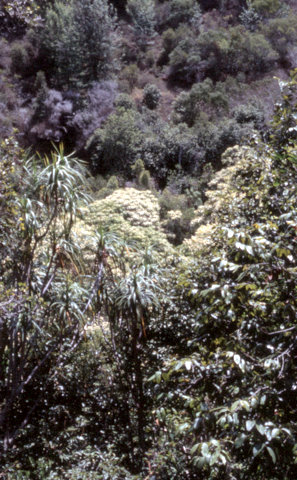
No, it's not in Brazil or Borneo. It's actually in the good old USA, literally and figuratively clinging to a steep slope in a drainage called Mahanaloa Gulch on the Hawaiian Island of Kauai. We need to stop twiddling our thumbs and SAVE THIS FOREST NOW.
I first visited this mystical forest shortly after I began a postdoctoral fellowship in restoration ecology at the National Tropical Botanical Garden in 1996. To my novice eyes, this gulch contained a beautiful but bewildering quilt of plants. Even more bewildering was the fact that several species I had recently seen elsewhere in the archipelago looked so different (what had been, say, a small shrub on another island had magically transformed into a vinelike tree here) that I never would have recognized them without my colleagues' help.
What also struck me about this remnant forest was that every other plant seemed to be another federally endangered species found only on Kauai. We later realized that since 1) Hawaii has the world's most unique and endangerment flora, 2) Kauai has the most unique and endangered flora of all the Hawaiian Islands, and 3) Mahanaloa Gulch has the most unique and endangered flora on Kauai, to the best of our knowledge, that particular forest contained the most unique and endangered flora on the planet!
As detailed in a forthcoming paper, we also discovered that over 80% of the 226 native plant species within a 50 acre section of this forest are unique to Hawaii, and 18 of these species are endangered. When we included other similar areas on the island outside of that gulch, we found a total of 317 native plant species, 84% of which were unique to Hawaii, and 37% of these occurred only on Kauai. We also found that 43 of these species are endangered, 20 have fewer than 50 individuals remaining in the wild, and two may already be extinct.
Hawaii's unrivaled levels of uniqueness and endangerment are largely due to the fact that very few species were able to get to and establish in these remote islands on their own. For example, our best estimates are that before humans, there was only one successful plant colonization every 98,000 years, and one successful bird colonization every million years. However, the lucky few that did make it to Hawaii suddenly found themselves in a world without most of the dominant species (mammals, reptiles, ants, etc.) that had constrained their evolution back home. Consequently, the subsequent "Hawaiian-style" evolution of some of those original colonists are arguably the most spectacular in the world. For instance, over 40 species of exquisite honeycreeper songbirds ultimately evolved from a single finch-like ancestor. If Darwin had ended up in Hawaii instead of the Galapagos, he undoubtedly would have figured it all out a lot faster.
Tragically, however, we are continuing to lose much of Hawaii's biodiversity in general and Kauai's in particular. For example, most of that remnant forest in Mahanaloa Gulch remains unprotected from the ravages of noxious alien weeds and ruthless feral pigs and deer. While some hard-boiled individuals believe we should practice ecological triage and give up on these islands, I think we should put our money where our endangered species are and make preserving and restoring such areas one of our highest conservation priorities. Indeed, numerous organizations have shown that we can save such areas when we put our hearts and minds together. For instance, the Kokee Resource Conservation Program alone has killed over seven million weeds and effectively restored numerous natural areas on Kauai.
After all, if we Americans fail to preserve and restore our only tropical ecosystems, can we continue to lecture the Brazils and Borneos of the world about the importance of saving theirs?
Photo courtesy of Steve Weller.